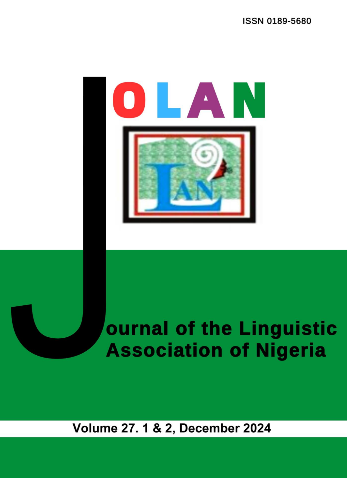Elements of film language: The Cinematographer’s tools for visual communication
Keywords:
Film, Language, Cinematography, Communication, Shot, Composition, Camera AnglesAbstract
Film is an art form and a popular medium of entertainment whose visual basis makes it a world-wide power of communication. The Nigerian film industry has achieved tremendous progress over the years on both the economic and cultural platforms. However, the problem is that the aesthetical and professional dimensions are plagued by technical glitches regarding competence in the area of cinematography for visual communication. Nigerian films have too much dialogue; rather than show visually, it is dialogue that tells the story. Early films of the silent era1890s were one static shot from a bulky camera as actors performed within that camera frame. David W.Griffith is credited as the film director who invented the close-up shot which moved the audience on to the stage. Thus the language of film was born. To achieve effective visual communication in film, this work focuses on the technical elements of film production highlighting the import of visual communication in film, namely; shots, shot sequences, shot composition, lighting, use of colour, sets and editing to communicate ideas, emotions and themes just as written languages use alphabets, words, sentences and paragraphs to create meaning. Furthermore, the work examines selected works of Nigerian filmmakers and evaluates the extent to which they use these cinematic elements to tell a visual story. The research design of the paper is descriptive using qualitative research method, The thrust of this paper is anchored on the fact that films convey meaning through use of codes and conventions similar to the way other languages construct meaning in communication and filmmakers should employ visual language using pictures to show and communicate in a more informative, meaningful and subtle manner. The major findings of the paper support the popular mantra “film is a visual medium” which is a truism as words tell while a picture shows and communicates reality hence the aphorism a picture is worth a thousand words. In conclusion, the paper recommends that since the visual language of film transcends geographical boundaries enabling stories to be presented with a universal appeal by the simultaneous signification of film syntax, camera work, mise-en-scene, film techniques, montage, content and style, filmmakers should adopt this approach to enhance their skills with the knowledge of the psychological, creative and communicative impact of these cinematic and theatrical elements which are some of the most useful tools film directors employ to speak the visual language of film in order to communicate with a heterogeneous society.
,
References
Abrams, N., Ian, B., and Jan, U. (2001). Studying film. New York, Oxford University Press.
Arnhein, R. (1964). Film as art. Los Angeles, University of California Press.
Braddeley, W. H. (1975). The technique of documentary film production. London, Focal Press.
Brownlow, Kevin. (1968). The Parade’s Gone By. Los Angeles: University of California Press.
Cook, P., and Mieke, B. (eds). (1999). The cinema book. 2nd Edition, London: BFI,
Drew, W., D. W. Griffith. (1875 – 1948) – Gilda’s Attic, Retrieved from http://www.gildasattic.com/dwgriffith.html
Esty, W. (2017) The language of mathematics. Retrieved from estymath.com/index.html
Heiderich, T. Cinematography Techniques: The different types of shots in film. Retrieved from https://www.videomaker.com>cinemato...
Henderson, R. M., D.W. Griffith. Encyclopedia Britannica inc. October 26, 2012.
https://www.videomaker.com/article. Visual language: Using visual language as a cinematic Structure.
Kraft, R. N. (1987). The Influence of camera angle on comprehension and retention of pictorial events. Memory and cognition. Retrieved from http://dx.doi.org/10.3758/BF3197032
Leyda, J. (1949). Sergei Eisenstein. Film Form: Essays in film theory. New York, Harcourt Brace Jovanovich.
Mandel, L. M. and Shaw, L. S. (1973). Judging People in the News-Unconsciously: The effect of camera angle and bodily activity. Journal of Broadcasting, 17.
Mascelli, V. C. J. (1979). The Five C’s of Cinematography, Hollywood. Cine/Grafic Publications.
Meyers-Levy, J. and L. A. Peracchio. (1992). Getting an angle on advertising: The effect of camera angle on product
evaluations. Journal of Marketing Research., 29.4
Monaco, J. (1981). How to read a film. Oxford University Press.














